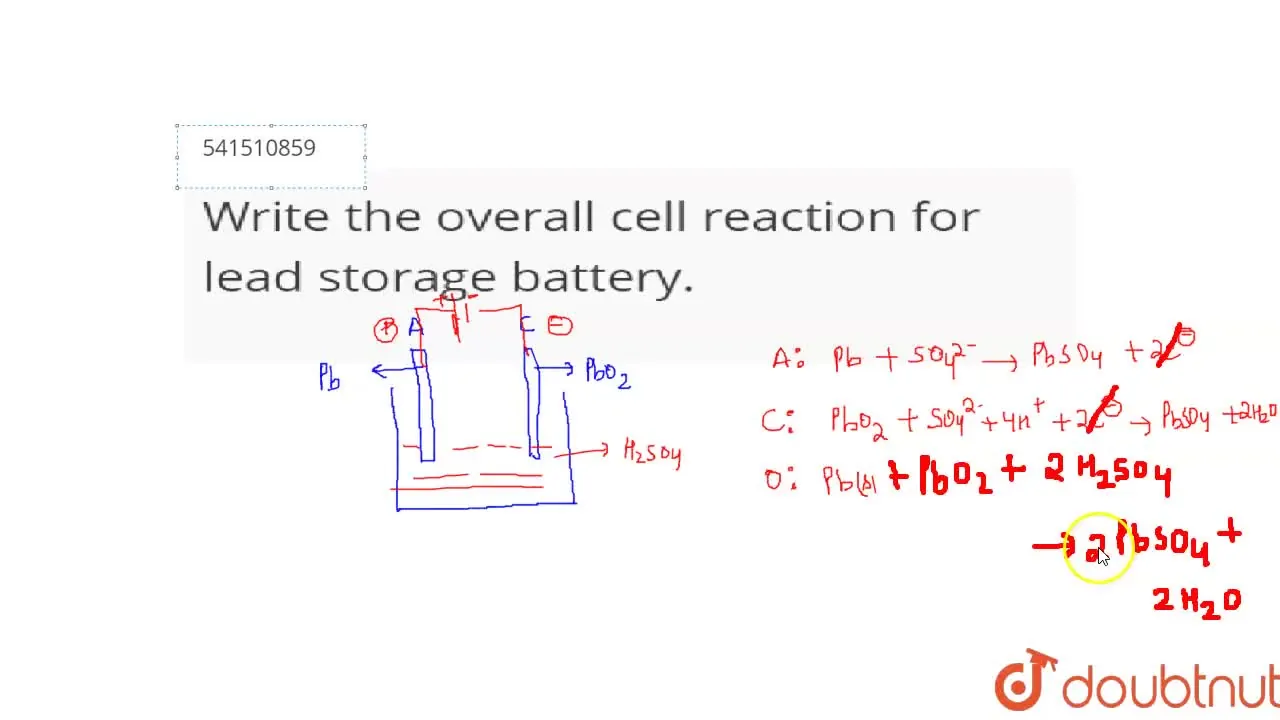Write the overall cell reaction for lead storage battery.
Step by step video & image solution for Write the overall cell reaction for lead storage battery. by Chemistry experts to help you in doubts & scoring excellent marks in Class 12 exams.
Related Playlists
- BOOK - MODERN PUBLICATIONCHAPTER - ELECTROCHEMISTRY EXERCISE - REVISION EXERCISES OBJECTIVE QUESTIONS Short Answer Questions46videos
ELECTROCHEMISTRY
- BOOK - MODERN PUBLICATIONCHAPTER - ELECTROCHEMISTRY EXERCISE - REVISION EXERCISES OBJECTIVE QUESTIONS Long Answer Questions11videos
ELECTROCHEMISTRY
- BOOK - MODERN PUBLICATIONCHAPTER - ELECTROCHEMISTRY EXERCISE - REVISION EXERCISES OBJECTIVE QUESTIONS (Assertion Reason Questions)10videos
ELECTROCHEMISTRY
- BOOK - MODERN PUBLICATIONCHAPTER - D AND F-BLOCK ELEMENTSEXERCISE - UNIT PRACTICE TEST12videos
D AND F-BLOCK ELEMENTS
- BOOK - MODERN PUBLICATIONCHAPTER - GENERAL PRINCIPLES AND PROCESSES OF ISOLATION OF ELEMENTSEXERCISE - COMPETION FILE (Integer Type Numerical Value Type Questions)5videos
GENERAL PRINCIPLES AND PROCESSES OF ISOLATION OF ELEMENTS
Similar Questions
(i) For a weak electrolyte molar conductance in dilute solution increases sharply as its concentration in solution is decreased. Give reason.
(ii) Write overall cell reaction for lead storage battery when the battery is being charged.View SolutionIn a lead storage battery
View Solution(a) The conductivity of 0.001 mol L−1 solution of CH3COOH is 3.905×10−5Scm−1. Calculate its molar conductivity and degree of dissociation (α).
Given :λ∘(H+)=349.6Scm2mol−1 and λ∘(CH3COO−)=40.9Scm2mol−1
(b) What type of battery is lead storage battery ? Write the overall reaction occurring in lead storage battery.View SolutionWrite the cell reaction of a lead storage battery when it is discharged. How does the density of the electrolyte change when the battery is discharged?
View SolutionWrite the cell reaction of a lead storage battery when it is discharged. How does the density of the electrolyte change when the battery is discharged ?
View SolutionWrite the cell reaction of a lead storage battery when it is discharged. How does the density of the electrolyte change when the battery is discharged?
View SolutionWrite the cell reaction of a lead storage battery when it is discharged. How does the density of the electrolyte change when the battery is discharged ?
View SolutionWrite the anode and cathode reactions and the overall reaction occurring in a lead storage battery.
View Solution(a) What type of a cell is the lead storage battery ? Write the anode and the cathode reactions and the overall reaction occuring in a lead storage battery while operating .
(b) A voltaic cell is set up at 25∘C with the half-cells , Al∣Al3+(0.001M) and Ni∣Ni2+(0.50M). Write the equation for the reaction that occurs when the cell generates an electric current and determine the cell potential.
(Given : E∘Ni2+∣Ni=−0.25V,E∘Al3+∣Al=−1.66V).View SolutionWhat type of a battery is lead storage battery? Write the anode and the cathode reactions and the overall reactions occurring in a lead storage battery.
View Solution


